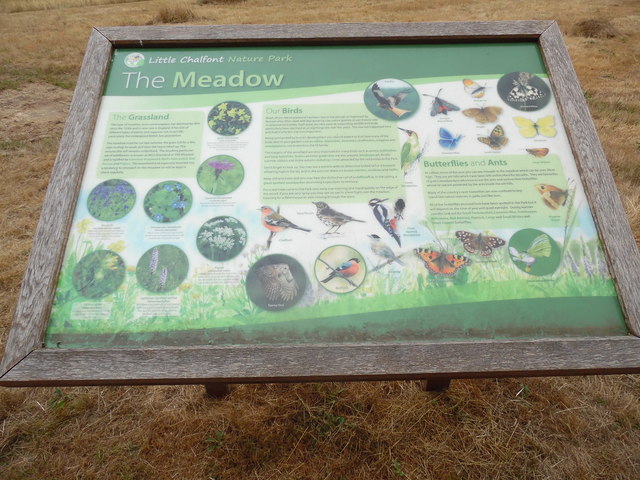Information Board in Little Chalfont Nature Park (2)
Introduction
The photograph on this page of Information Board in Little Chalfont Nature Park (2) by David Hillas as part of the Geograph project.
The Geograph project started in 2005 with the aim of publishing, organising and preserving representative images for every square kilometre of Great Britain, Ireland and the Isle of Man.
There are currently over 7.5m images from over 14,400 individuals and you can help contribute to the project by visiting https://www.geograph.org.uk

Image: © David Hillas Taken: 11 Aug 2018
Located in Little Chalfont Nature Park off Cokes Lane HP7 9QA, this information board has the following wording: The Meadow Left hand side The Grassland This type of meadow, once commonplace, has declined by 90% since the 1930s and is now rare in England. It has lots of different types of plants and supports rich insect life, particularly the endangered British bee population. The meadow must be cut late summer, the grass left for a few days to drop its seeds and then the hay is raked up. This ensures the soil remains unfertilised. The resulting set of wildflowers is known as MGS Grassland or 'Old Meadow' and is typified by Common Knapweed, Bird's-foot trefoil, Red Fescue and Pignut. The woodland and especially bramble has a tendency to encroach the meadow so will be kept in check regularly. Surrounding this description are the following photos: i) Bird's-foot-trefoil (Lotus corniculatus) Seed pods look like a bird's foot; also known as Bacon-and-eggs because the buds are often orange' food plant for caterpillars of the Common Blue butterfly. ii) Bluebell (Hyacinthoides non-scripta) Associated with ancient woodland, a protected species, rich in pollen and nectar and chiefly pollinated by bumblebees. iii) Germander Speedwell (Veronica chamaedrys) Also known as Bird's eye because of the very pretty blue flowers with a white eye edged with purple. iv) Common Knapweed (Centaurea nigra) Part of the daisy family, bright purple flowers, also known as 'Hardheads'. v) Yellow-rattle (Rhinanthus minor) In olden days, the rattling of the ripe seed heads told farmers when to cut the hay. vi) Common Spotted-orchid (Dactylorchiza fuchsia) Pink flowers (occasionally white) marked with loops and dots and spotted leaves that give the plant its name. Blooms between June and August. vii) Pignut (Conopodium majus) Pretty white flowers like lace; in the same family as carrots and parsnips and has an edible root that pigs love to dig up, so should really be called Pigroot! Middle Our Birds Much of our native grassland has been lost to the ploughs or 'improved' by farmers who often seed with fast growing non-native species or use insecticides or selective herbicides. Such areas are very poor at supporting wildlife and birds particularly have declined at an alarming rate over the years. This has not happened here and that is why this site is so important. Being surrounded by human development you should expect to find here many of the birds seen in your garden such as robins, blackbirds, dunnocks, chaffinches, magpies and woodpigeons, not to mention the tit family. The margins of the woodland are very important for many birds such as wrens, bullfinches and long-tailed tits. Siskins and tiny goldcrests are also present, blackcaps are mostly summer visitors and in the autumn redwings come, attracted by the red berries in the Park. Don't forget to look up. You may see a red kite with its distinctive forked tail or a buzzard wheeling high in the sky and in the summer there are house martins, swallows and swifts. Keep still and listen and you may hear the distinctive call of a chiffchaff or, in the spring, a great spotted woodpecker drumming to proclaim its territory. For a real treat come to the Park very early one morning and stand quietly on the edge of the wood. If you are very lucky you may see an owl in silent flight over the meadow, listening for a field mouse or vole moving through the grass. Surrounding this description are photos of the following birds: Chaffinch, Song Thrush, Tawny Owl, Bullfinch, Blackcap, Great Spotted Woodpecker, Red Kite and Green Woodpecker. Right hand side Butterflies and Ants At certain times of the year you can see mounds in the meadow which can be over 30cm high. They are ant hills which have been left undisturbed for decades. They are favourites of green woodpeckers who love to eat the ants and various blue butterflies whose larvae are protected by the ants inside the ant hills. Many of the country's rarer butterflies are now confined to tiny island-like nature reserves in parks just like ours. All of the butterflies pictured here have been spotted in the Park but it will depend on the time of year and good eyesight. During warmer months, look out for Small Tortoiseshell, Common Blue, Gatekeeper, Brimstone, Red Admiral, Peacock, Large and Small Whites and Small copper butterflies. Surrounding this description are photos of the following butterflies and moths: Six-spot Burnet Moth, Orange-tip, Ringlet, Common Blue, Marbled White, Small Copper, Brimstone, Large Skipper, Meadow Brown, Small Tortoiseshell, Speckled Wood and Green-veined White.

